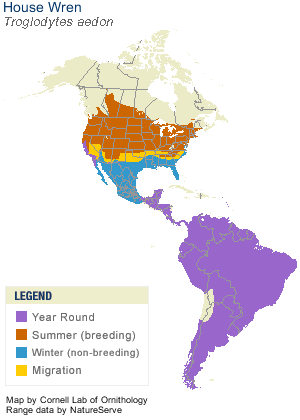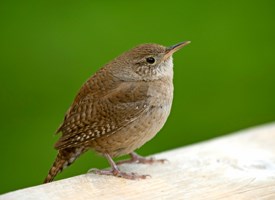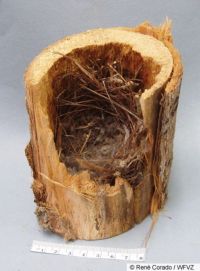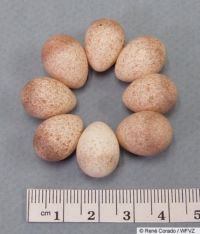 |
Canku Ota
|
 |
|
(Many Paths)
|
||
|
An Online Newsletter
Celebrating Native America
|
||
|
August 2015 - Volume
13 Number 8
|
||
|
|
||
|
House Wren
(Troglodytes aedon) |
||
|
by Cornell Lab of Ornithology
|
||
A plain brown bird with an effervescent voice, the House Wren is a common backyard bird over nearly the entire Western Hemisphere. Listen for its rush-and-jumble song in summer and you’ll find this species zipping through shrubs and low tree branches, snatching at insects. House Wrens will gladly use nestboxes, or you may find their twig-filled nests in old cans, boots, or boxes lying around in your garage.
Life History

Cool Facts
Eats a wide variety of insects and spiders, including beetles, caterpillars, earwigs, and daddy longlegs, as well as smaller numbers of more mobile insects such as flies, leafhoppers, and springtails. Also eats snail shells, probably for the calcium they contain and to provide grit for digestion. Nesting
Nest Description House Wrens pile twigs into the cavities they choose to nest in, either to make a bed on which to build a soft-lined cup, or sometimes mounded up into a barrier between nest and entrance, seemingly to protect the nest from cold weather, predators, or cowbirds. The cup itself is built into a depression in the twigs and lined with just a few grams (less than 0.25 oz) of feathers, grasses and other plant material, animal hair, spider egg sacs, string, snakeskin, and discarded plastic.
House Wrens nest in old woodpecker holes, natural crevices, and nest boxes (or discarded tins, shoes, etc.) provided by humans. This bird’s association with open woodland is reflected in its choice of nest sites: it rarely uses nest sites more than 100 feet from woody vegetation, but also avoids heavily wooded nest sites where it’s hard to see predators coming. Despite their small size, they can be fierce competitors for nest sites, sometimes evicting a larger species and claiming its cavity after the bird has already begun nesting.
A busy forager in low tree branches and shrubs. You’ll occasionally see these birds flit across openings with steady, level flight, or investigating the ground with quick hops. Male House Wrens start building several nests at once in hopes of persuading a female to mate with him. Pairs typically break up by the end of each nesting season and choose new partners the next year. House Wrens are aggressive. Single males sometimes compete for females even after a pair has begun nesting. In about half of these contests the outsider succeeds in displacing his rival, at which point he usually discards any existing eggs or nestlings and begins a new family with the female.
House Wren populations have experienced some declines, notably in the northeast areas of their U.S. and Canada range, but generally from 1966 to 2010 populations have been stable and slightly increasing, according to the North American Breeding Bird Survey. Partner's in Flight estimates the total breeding population at 160 million with 19 percent spending some part of the year in the U.S., 9 percent in Mexico, and 8 percent breeding in Canada. They rate a 5 out of 20 on the Continental Concern Score and are not on the 2012 Watch List.
|
||||||||||||||||||||||||||||||||||||||||||
|
|
||
|
|
||
| Canku Ota is a free Newsletter celebrating Native America, its traditions and accomplishments . We do not provide subscriber or visitor names to anyone. Some articles presented in Canku Ota may contain copyright material. We have received appropriate permissions for republishing any articles. Material appearing here is distributed without profit or monetary gain to those who have expressed an interest. This is in accordance with Title 17 U.S.C. Section 107. | ||
|
Canku Ota is a copyright ©
2000 - 2015 of Vicki Williams Barry and Paul Barry.
|
||
 |
 |
|
|
The "Canku
Ota - A Newsletter Celebrating Native America" web site and
its design is the
|
||
|
Copyright ©
1999 - 2015 of Paul C. Barry.
|
||
|
All Rights Reserved.
|
||







